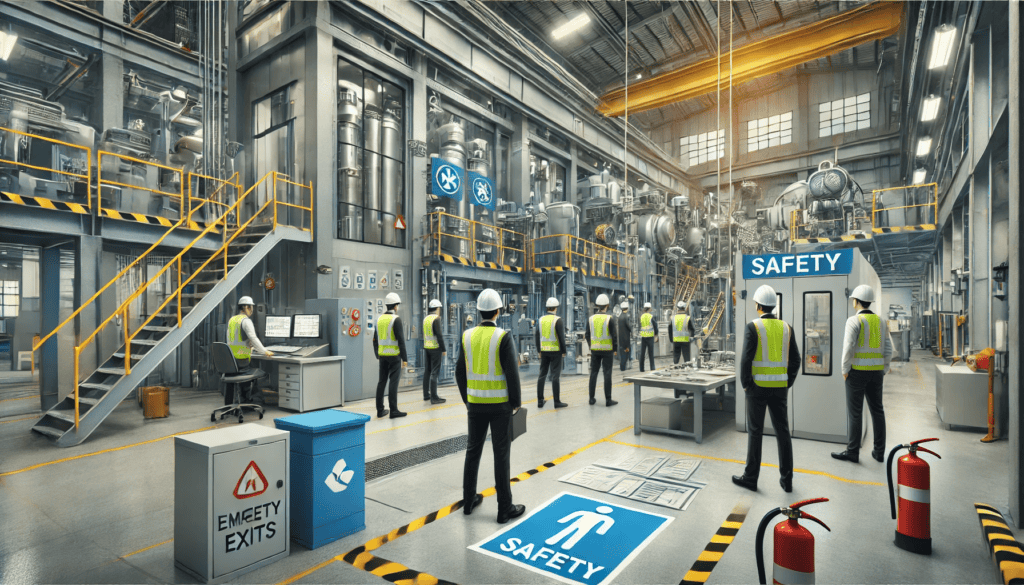Enhancing Factory Safety: Best Practices for a Secure Work Environment
Factory safety is paramount to ensuring the well-being of employees and the efficiency of operations. A safe factory environment not only protects workers from potential hazards but also enhances productivity and morale. This article explores key strategies and best practices for maintaining a secure factory work environment.
The Importance of Safety Protocols
Implementing and adhering to safety protocols in a factory setting is essential. These protocols help prevent accidents and injuries, ensuring that the workplace remains safe for all employees.
- Compliance with Regulations: Ensure your factory complies with all relevant health and safety regulations, including the Health and Safety at Work etc. Act 1974.
- Safety Training: Regularly conduct safety training sessions for all employees to keep them informed about the latest safety procedures and protocols.
- Personal Protective Equipment (PPE): Provide and enforce the use of appropriate PPE, such as high-visibility vests, helmets, gloves, and safety goggles.
Conducting Routine Safety Inspections
Regular safety inspections are crucial for identifying potential hazards and ensuring that safety measures are being followed correctly.
- Scheduled Inspections: Conduct routine safety inspections at regular intervals. This helps in early detection of any safety issues that need to be addressed.
- Checklists: Use comprehensive checklists to ensure all aspects of factory safety are covered during inspections. This includes checking machinery, emergency exits, fire extinguishers, and PPE usage.
- Documentation: Keep detailed records of all safety inspections and the actions taken to address any identified issues.
Emergency Preparedness
Being prepared for emergencies is a critical component of factory safety. Ensuring that all employees know how to respond in an emergency can save lives and minimise damage.
- Emergency Exits: Clearly mark and keep all emergency exits unobstructed. Conduct regular drills to ensure employees know how to evacuate safely.
- Fire Safety: Install and maintain appropriate fire safety equipment, such as fire extinguishers and smoke detectors. Train employees in the use of this equipment.
- First Aid: Ensure that first aid kits are easily accessible and that there are trained first aiders on site.
Proper Equipment Usage
Using machinery and equipment safely is fundamental to preventing workplace injuries. Proper training and maintenance are key components of equipment safety.
- Training: Provide comprehensive training on the correct use of all machinery and equipment. Refresher courses should be conducted regularly.
- Maintenance: Ensure all machinery is regularly maintained and serviced to prevent malfunctions. Faulty equipment should be reported and repaired promptly.
- Safety Guards: Use safety guards on all machinery to protect workers from moving parts and other hazards.
Promoting a Safety Culture
Creating a culture of safety within the factory can significantly enhance compliance with safety protocols and reduce the risk of accidents.
- Leadership Commitment: Ensure that management demonstrates a strong commitment to safety. This sets a positive example for all employees.
- Employee Involvement: Involve employees in safety initiatives and encourage them to voice their safety concerns and suggestions.
- Rewarding Safe Practices: Recognise and reward employees who consistently follow safety protocols and contribute to a safer workplace.
Addressing Specific Hazards
Different factories have different hazards based on the nature of their operations. Identifying and addressing these specific hazards is crucial.
- Chemical Safety: If your factory uses chemicals, ensure proper storage, handling, and disposal procedures are in place. Provide appropriate PPE and training on chemical safety.
- Noise Control: High noise levels can cause hearing damage. Use noise control measures and provide hearing protection to employees working in noisy areas.
- Manual Handling: Train employees in proper lifting techniques to prevent musculoskeletal injuries. Use mechanical aids where possible to reduce the need for manual handling.
Conclusion
Ensuring factory safety is an ongoing process that requires vigilance, commitment, and continuous improvement. By adhering to safety protocols, conducting regular inspections, preparing for emergencies, ensuring proper equipment usage, promoting a safety culture, and addressing specific hazards, factories can create a safe and productive work environment.
Implementing these best practices will not only protect employees but also enhance operational efficiency and productivity, contributing to the overall success of the factory.

